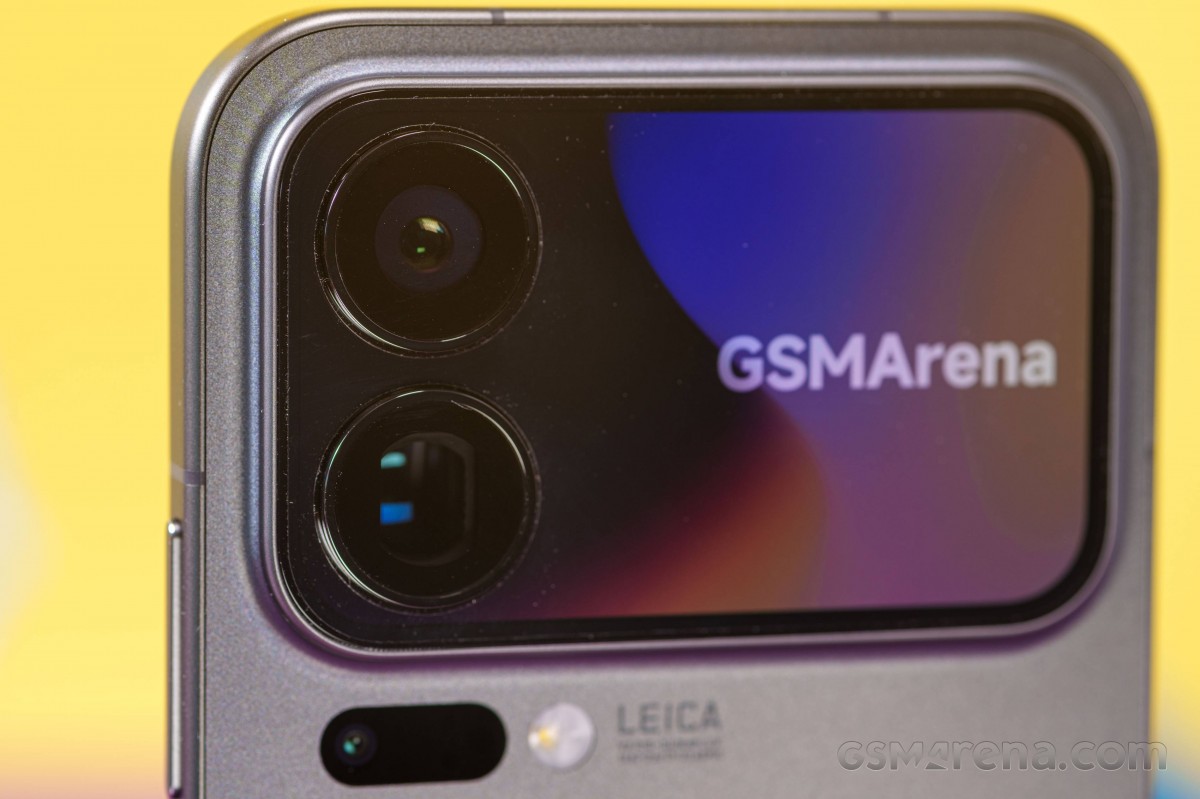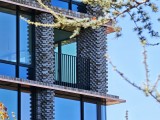Four 50MP cameras, one periscope telephoto
The Xiaomi 17 Pro Max brings some subtle changes to the camera system, compared to the 15 Pro last year. The keyword is “changes” as not everything is actually an upgrade.

For instance, the main 50MP camera has a smaller aperture, but uses an improved, bigger Light Fusion 950L sensor, again with Leica Summilux optics. The telephoto unit gains a larger sensor, too, after engineers tinkered with the prism layout to accommodate a larger unit. Slightly narrower aperture is used, though.
- Wide (main): 50MP Light Fusion 950L (possibly Smartsens SC590XS), f/1.7, 1/1.28″, 23mm, 1.22µm, ToF-assisted dual-pixel PDAF, OIS; 8K@30fps.
- Telephoto 5x: 50MP Samsung ISOCELL (S5K)GN8, f/2.6, 1/1.95″, 0.8µm, PDAF, OIS; 4K@30fps.
- Ultra wide angle: 50MP OmniVision OV50M40, f/2.4, 1/2.88″, 17mm, 0.61µm, PDAF; 4K@30fps
- Front camera: 50MP OmniVision OV50M40, f/2.2, 1/2.88″, 21mm, 0.61µm, PDAF; 4K@30fps
The ultrawide camera is, at least on paper, a downgrade. It has a narrower FoV and a narrower aperture, but still has autofocus.

Perhaps the most notable upgrade in this year’s camera system is the selfie. Xiaomi is finally replacing the aging 32MP selfie camera it has used for generations with a nicer 50MP camera with autofocus. Somewhat ironic given that this year’s Xiaomi 17 Max’s rear screen makes it so easy to take excellent selfies with the rear camera that your selfie camera might not see as much action as on other phones.
Below is our image quality analysis, but you can also check out the photo gallery in our hands-on review, as you will find even more photo samples there.
Daylight photos
Main camera
The overall quality of the main camera during the day is pretty solid. It maintains clean and sharp image quality even indoors, but some moving objects could be sharper. Objectively speaking, the main camera is excellent and can compete with the very best in the industry – sharp, detailed photos with no noise and a wide dynamic range.
However, the post-processing has its quirks, which some of you may not find appealing. For instance, some shots could use a bit more contrast, especially in slightly more challenging lighting conditions. Additionally, while colors are somewhat accurate – conservative, even – there’s a strong tendency to oversaturate the reds and, sometimes, the greens.
Xiaomi 17 Pro Max vs. Xiaomi 15 Ultra: We also couldn’t miss the opportunity to compare the Xiaomi 17 Pro Max and Xiaomi 15 Ultra cameras side by side. You will see these comparisons sprinkled through this page. In most photos, it’s hard to tell the difference between the main cameras of the two Xiaomi phones, which is to be expected. However, some scenes reveal interesting findings. For instance, the 17 Pro Max renders fine detail in the shadows much better, conserving foliage and building facades. It also tends to produce warmer-looking images, bringing out fall colors. On the other hand, the 15 Ultra has an overall better dynamic range and nicer contrast.










Main cameras: 17 Pro Max • 15 Ultra
We also took a few full-res 50MP shots, but those are largely unimpressive.
Here are some people’s photos at 23mm in the standard Photo mode and the dedicated Portrait mode. We have to say we are fans of how the the skin rendition has come out and the defocused background in Portrait mode is recreated really profficently with nice subject separation.








People photos: Photo mode • Portrait mode
2x crop zoom
The system extracts nice 2x crops from the main camera with minimal loss of sharpness. Some objects with fine detail in the distance may appear fuzzier, like building facades and foliage, but that’s par for the course. The 2x zoom crops are quite dependable and consistent indoors.
Xiaomi 17 Pro Max vs. Xiaomi 15 Ultra: In the 2x crop comparison, there is hardly any difference between the two phones and our preference for which phone is better changes from scene to scene.










2x main cam crop: 17 Pro Max • 15 Ultra
And here are photos of people in the Photo and Portrait modes.








2x crop zoom: Photo mode • Portrait mode
5x telephoto camera
The telephoto camera matches the main camera’s processing overall, but fails to impress when it comes to quality in general. Many of the photos we took were either blurry or fuzzy, suggesting the OIS is not doing a great job.












5x telephoto camera daylight photos
Xiaomi 17 Pro Max vs. Xiaomi 15 Ultra: It’s no surprise that the 15 Ultra delivers far better stills with its telephoto camera. They are a lot sharper, more detailed and with slightly wider dynamic range. And even though it has a shorter zoom at 4.2x magnification, the larger sensor allows you to crop way beyond 4.2x and still get excellent shots. The 17 Pro Max’s telephoto, however, fails to impress even at native 5x zoom.








Telephoto cameras: 17 Pro Max (5x) • 15 Ultra (4.2x)
People shots look great, and the Portrait mode again shows some excellent subject separation from the artificially defocused background.








5x telephoto: Photo mode • Portrait mode
The Xiaomi 17 Pro Max telephoto camera supports close-focusing from as close as 30cm and you can snap the occasional nice-looking closeups with it.





Macro shots with 5x telephoto camera
10x crop zoom
The 10x crops from the 5x telephoto camera are a bit fuzzier but generaly look okay.
Ultrawide camera
The ultrawide camera is more than decent in the more general sense. Sharpness and detail are okay, but the dynamic range is pretty wide, maybe even above average for an ultrawide shooter. However, the field of view is not as wide as we expected, sitting at 102-degree FoV with 17mm focal length. That’s quite close to the main camera’s 23mm, which is on the wider side already.
The post-processing matches the main camera’s, cranking up the reds, while keeping the rest of the colors more conservative. Contrast needs a little boost, too.












Ultrawide camera daylight photos
Xiaomi 17 Pro Max vs. Xiaomi 15 Ultra: Overall, we like the 15 Ultra’s ultrawide camera better as it has a proper wide field of view, while the 17 Pro Max settles for a narrower lens (13mm vs. 17mm). Due to that, the 17 Pro Max’s ultrawide shots are somewhat sharper, but the 15 Ultra’s stills have better dynamic range and nicer contrast.










Ultrawide cameras: 17 Pro Max • 15 Ultra
Selfie photos
The front-facing selfie camera has autofocus and all selfies we took were quite sharp. The subject’s face is always well-exposed and there’s plenty of detail.
We are not fans of how the contrast, facial features and hair are rendered. Then again, this selfie tuning might be set by Xiaomi with the Chinese market in mind.







Dedicated selfie camera photos
Xiaomi 17 Pro Max vs. Xiaomi 15 Ultra: Post-processing-wise, the selfies look very similar. The newer 50MP shooter on the 17 Pro Max, however, wins with a more detailed and maybe even sharper rendition.




Front cameras: 17 Pro Max • 15 Ultra
But why use the front-facing camera, when you can use the display on the back to frame yourself for selfies with the rear cameras?
We are not particularly impressed by the ultrawide camera’s quality in this use case, but it will get the job done if you have to fit more people into the frame.
The main camera, on the other hand, delivers excellent self-portraits with a nice and natural background blur.
The 2x crop zoom selfies from the main camera are also spotless. We highly recommend using the rear camera as your primary selfie shooter.




















Rear camera selfies: 0.6x • 1x • 2x
Low-light photos
Main camera
The main camera’s low-light photos come out excellent. The phone exposes well and delivers well-developed shadows and highlights, and absolutely no noise. We could wish the contrast was a bit higher in some of the shots, but it’s nitpicking. Night mode is completely automatic.
Xiaomi 17 Pro Max vs. Xiaomi 15 Ultra: There’s little to no difference when it comes to quality and clarity, but the 15 Ultra tends to deliver higher-contrast images with more accurate color temperature.






Main cameras: 17 Pro Max • 15 Ultra
2x crop zoom
The 2x crop zoom quality is more than decent, in the context of the 1x shots above. There’s minimal loss in quality, and it’s still free from noise.
Xiaomi 17 Pro Max vs. Xiaomi 15 Ultra: The low-light 2x crops look somewhat similar, with again the 15 Ultra capturing the color temperature more accurately. In some cases, the 17 Pro Max’s 2x crops are more likable thanks to the extra sharpening.






2x crops: 17 Pro Max • 15 Ultra
5x telephoto camera
The 5x telephoto shots at night won’t hold up to close scrutiny as they are not terribly sharp. However, they have good dynamic range and a clean rendition, with no noise. The color temperature is once again too warm.







5x telephoto camera low-light photos
Xiaomi 17 Pro Max vs. Xiaomi 15 Ultra: The 4.2x telephoto camera on the 15 Ultra is once again the clear winner here with sharper, more detailed photos. Contrast and dynamic range are also better on the 15 Ultra.








Telephoto cameras: 17 Pro Max (5x) • 15 Ultra (4.2x)
10x crop zoom
The sensor used for the telephoto camera reaches its limits when you ask it to crop by a factor of 2x. The 10x crop zoom stills are way too soft and fuzzy.







10x crop zoom low-light photos
Ultrawide camera
The ultrawide camera’s low-light photos are not very competitive. They lack fine detail, and sharpness isn’t up to snuff, even for an ultrawide camera. Color temperature is off, like on the other two cameras.







Ultrawide camera low-light photos
Xiaomi 17 Pro Max vs. Xiaomi 15 Ultra: The 15 Ultra’s ultrawide camera is once again better, but in addition to delivering stills with nicer colors and contrast, they are also a lot sharper and more detailed.








Ultrawide cameras: 17 Pro Max • 15 Ultra
Video recording
The handset supports up to 8K video recording at 30fps using its main camera, while the rest of the cameras cap at 4K@60fps. EIS is available with all cameras and virtually all camera modes. Additionally, the 17 Pro Max supports advanced video capture capabilities, including HDR10+, 10-bit Dolby Vision HDR, and 10-bit LOG, in case you’d like to do the color grading yourself.
You can check out the playlist below, which includes multiple video samples.
The main camera’s performance during the day and night is pretty solid. Both videos show excellent fine detail, good sharpness, excellent dynamic range, and virtually non-existent noise, even in the low-light video. However, stabilization isn’t the best we’ve seen, as there’s minor shakiness in all our 1x and 2x videos, even though the EIS test footage isn’t necessarily bad.
The daylight and low-light 2x videos are a bit too soft to our taste, and the low-light one is even noisier than expected. Still, there aren’t many good 2x crop zoom videos in the first place.
The 5x zoom video looks okay. Stabilization is good, but the clips have lower contrast than expected and can be generally fuzzy. We are quite happy with how the low-light footage comes out, though. The auto focus is not the best, but the dynamic range is great.
The daylight ultrawide video is generally good (as far as ultrawide videos go these days), with adequate sharpness and contrast. The dynamic range is narrower than the main camera’s, but that’s par for the course. The low-light ultrawide video is hard to recommend. It has a limited dynamic range, it is noisy, and it is way too soft.
Xiaomi 17 Pro Max vs. Xiaomi 15 Ultra: During the day, the two phones deliver similar-looking footage with all of their cameras. Especially the main camera videos. They look almost identical. However, the 15 Ultra edges out with ever so slightly sharper ultrawide camera and considerably better telephoto footage. The Ultra’s telephoto camera produces sharper and more detailed images with a wider dynamic range.








4К screengrabs: 17 Pro Max • 15 Ultra
At night, the 15 Ultra’s ultrawide and telephoto cameras continue to lead, but the 17 Pro Max’s main camera footage is more likable. It renders highlights better, although the color temperature is a bit off in all of the 17 Pro Max’s videos.








4К screengrabs: 17 Pro Max • 15 Ultra




















































